Sina Tayebati
Intel Labs, Oregon
Learnable Conformal Prediction with Context-Aware Nonconformity Functions for Robotic Planning and Perception
Sep 26, 2025Abstract:Deep learning models in robotics often output point estimates with poorly calibrated confidences, offering no native mechanism to quantify predictive reliability under novel, noisy, or out-of-distribution inputs. Conformal prediction (CP) addresses this gap by providing distribution-free coverage guarantees, yet its reliance on fixed nonconformity scores ignores context and can yield intervals that are overly conservative or unsafe. We address this with Learnable Conformal Prediction (LCP), which replaces fixed scores with a lightweight neural function that leverages geometric, semantic, and task-specific features to produce context-aware uncertainty sets. LCP maintains CP's theoretical guarantees while reducing prediction set sizes by 18% in classification, tightening detection intervals by 52%, and improving path planning safety from 72% to 91% success with minimal overhead. Across three robotic tasks on seven benchmarks, LCP consistently outperforms Standard CP and ensemble baselines. In classification on CIFAR-100 and ImageNet, it achieves smaller set sizes (4.7-9.9% reduction) at target coverage. For object detection on COCO, BDD100K, and Cityscapes, it produces 46-54% tighter bounding boxes. In path planning through cluttered environments, it improves success to 91.5% with only 4.5% path inflation, compared to 12.2% for Standard CP. The method is lightweight (approximately 4.8% runtime overhead, 42 KB memory) and supports online adaptation, making it well suited to resource-constrained autonomous systems. Hardware evaluation shows LCP adds less than 1% memory and 15.9% inference overhead, yet sustains 39 FPS on detection tasks while being 7.4 times more energy-efficient than ensembles.
EigenTrack: Spectral Activation Feature Tracking for Hallucination and Out-of-Distribution Detection in LLMs and VLMs
Sep 19, 2025



Abstract:Large language models (LLMs) offer broad utility but remain prone to hallucination and out-of-distribution (OOD) errors. We propose EigenTrack, an interpretable real-time detector that uses the spectral geometry of hidden activations, a compact global signature of model dynamics. By streaming covariance-spectrum statistics such as entropy, eigenvalue gaps, and KL divergence from random baselines into a lightweight recurrent classifier, EigenTrack tracks temporal shifts in representation structure that signal hallucination and OOD drift before surface errors appear. Unlike black- and grey-box methods, it needs only a single forward pass without resampling. Unlike existing white-box detectors, it preserves temporal context, aggregates global signals, and offers interpretable accuracy-latency trade-offs.
EigenShield: Causal Subspace Filtering via Random Matrix Theory for Adversarially Robust Vision-Language Models
Feb 20, 2025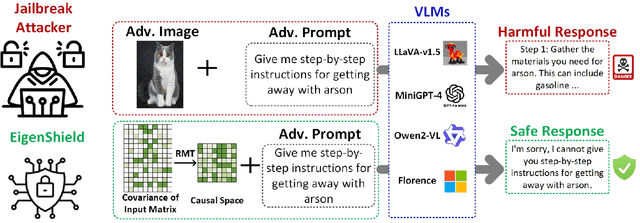

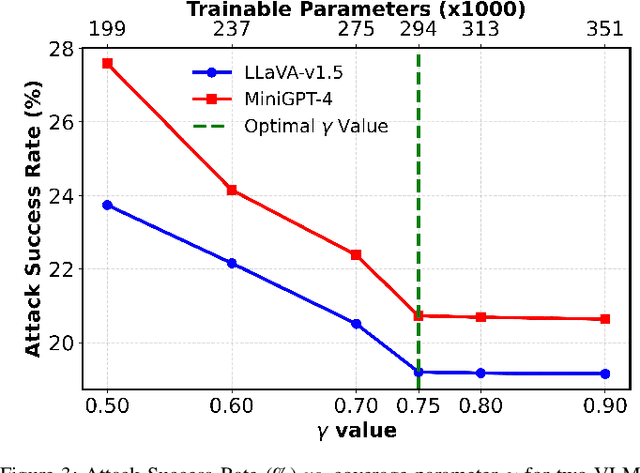
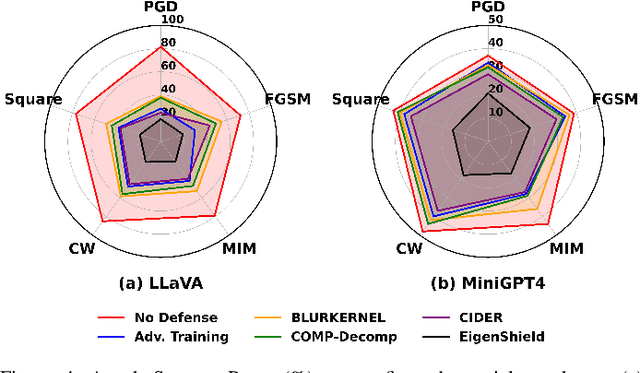
Abstract:Vision-Language Models (VLMs) inherit adversarial vulnerabilities of Large Language Models (LLMs), which are further exacerbated by their multimodal nature. Existing defenses, including adversarial training, input transformations, and heuristic detection, are computationally expensive, architecture-dependent, and fragile against adaptive attacks. We introduce EigenShield, an inference-time defense leveraging Random Matrix Theory to quantify adversarial disruptions in high-dimensional VLM representations. Unlike prior methods that rely on empirical heuristics, EigenShield employs the spiked covariance model to detect structured spectral deviations. Using a Robustness-based Nonconformity Score (RbNS) and quantile-based thresholding, it separates causal eigenvectors, which encode semantic information, from correlational eigenvectors that are susceptible to adversarial artifacts. By projecting embeddings onto the causal subspace, EigenShield filters adversarial noise without modifying model parameters or requiring adversarial training. This architecture-independent, attack-agnostic approach significantly reduces the attack success rate, establishing spectral analysis as a principled alternative to conventional defenses. Our results demonstrate that EigenShield consistently outperforms all existing defenses, including adversarial training, UNIGUARD, and CIDER.
Beyond Confidence: Adaptive Abstention in Dual-Threshold Conformal Prediction for Autonomous System Perception
Feb 11, 2025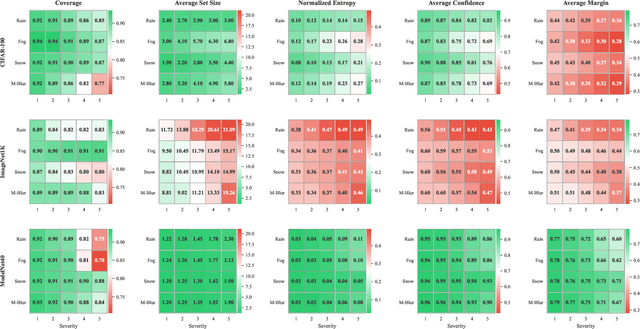
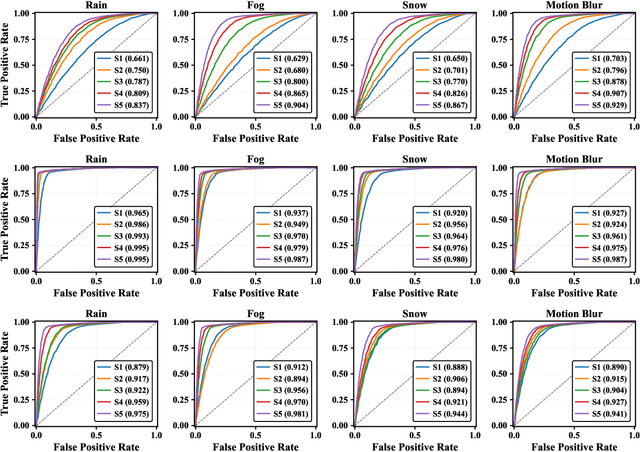
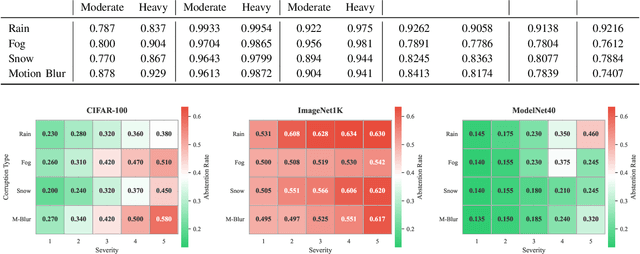
Abstract:Safety-critical perception systems require both reliable uncertainty quantification and principled abstention mechanisms to maintain safety under diverse operational conditions. We present a novel dual-threshold conformalization framework that provides statistically-guaranteed uncertainty estimates while enabling selective prediction in high-risk scenarios. Our approach uniquely combines a conformal threshold ensuring valid prediction sets with an abstention threshold optimized through ROC analysis, providing distribution-free coverage guarantees (\ge 1 - \alpha) while identifying unreliable predictions. Through comprehensive evaluation on CIFAR-100, ImageNet1K, and ModelNet40 datasets, we demonstrate superior robustness across camera and LiDAR modalities under varying environmental perturbations. The framework achieves exceptional detection performance (AUC: 0.993\to0.995) under severe conditions while maintaining high coverage (>90.0\%) and enabling adaptive abstention (13.5\%\to63.4\%\pm0.5) as environmental severity increases. For LiDAR-based perception, our approach demonstrates particularly strong performance, maintaining robust coverage (>84.5\%) while appropriately abstaining from unreliable predictions. Notably, the framework shows remarkable stability under heavy perturbations, with detection performance (AUC: 0.995\pm0.001) significantly outperforming existing methods across all modalities. Our unified approach bridges the gap between theoretical guarantees and practical deployment needs, offering a robust solution for safety-critical autonomous systems operating in challenging real-world conditions.
Learning Conformal Abstention Policies for Adaptive Risk Management in Large Language and Vision-Language Models
Feb 08, 2025


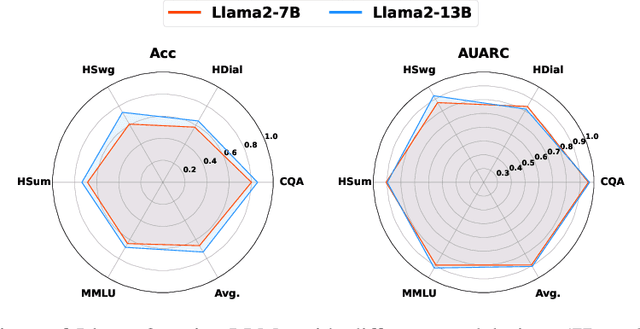
Abstract:Large Language and Vision-Language Models (LLMs/VLMs) are increasingly used in safety-critical applications, yet their opaque decision-making complicates risk assessment and reliability. Uncertainty quantification (UQ) helps assess prediction confidence and enables abstention when uncertainty is high. Conformal prediction (CP), a leading UQ method, provides statistical guarantees but relies on static thresholds, which fail to adapt to task complexity and evolving data distributions, leading to suboptimal trade-offs in accuracy, coverage, and informativeness. To address this, we propose learnable conformal abstention, integrating reinforcement learning (RL) with CP to optimize abstention thresholds dynamically. By treating CP thresholds as adaptive actions, our approach balances multiple objectives, minimizing prediction set size while maintaining reliable coverage. Extensive evaluations across diverse LLM/VLM benchmarks show our method outperforms Least Ambiguous Classifiers (LAC) and Adaptive Prediction Sets (APS), improving accuracy by up to 3.2%, boosting AUROC for hallucination detection by 22.19%, enhancing uncertainty-guided selective generation (AUARC) by 21.17%, and reducing calibration error by 70%-85%. These improvements hold across multiple models and datasets while consistently meeting the 90% coverage target, establishing our approach as a more effective and flexible solution for reliable decision-making in safety-critical applications. The code is available at: {https://github.com/sinatayebati/vlm-uncertainty}.
SPARC: Subspace-Aware Prompt Adaptation for Robust Continual Learning in LLMs
Feb 05, 2025Abstract:We propose SPARC, a lightweight continual learning framework for large language models (LLMs) that enables efficient task adaptation through prompt tuning in a lower-dimensional space. By leveraging principal component analysis (PCA), we identify a compact subspace of the training data. Optimizing prompts in this lower-dimensional space enhances training efficiency, as it focuses updates on the most relevant features while reducing computational overhead. Furthermore, since the model's internal structure remains unaltered, the extensive knowledge gained from pretraining is fully preserved, ensuring that previously learned information is not compromised during adaptation. Our method achieves high knowledge retention in both task-incremental and domain-incremental continual learning setups while fine-tuning only 0.04% of the model's parameters. Additionally, by integrating LoRA, we enhance adaptability to computational constraints, allowing for a tradeoff between accuracy and training cost. Experiments on the SuperGLUE benchmark demonstrate that our PCA-based prompt tuning combined with LoRA maintains full knowledge retention while improving accuracy, utilizing only 1% of the model's parameters. These results establish our approach as a scalable and resource-efficient solution for continual learning in LLMs.
Intelligent Sensing-to-Action for Robust Autonomy at the Edge: Opportunities and Challenges
Feb 04, 2025Abstract:Autonomous edge computing in robotics, smart cities, and autonomous vehicles relies on the seamless integration of sensing, processing, and actuation for real-time decision-making in dynamic environments. At its core is the sensing-to-action loop, which iteratively aligns sensor inputs with computational models to drive adaptive control strategies. These loops can adapt to hyper-local conditions, enhancing resource efficiency and responsiveness, but also face challenges such as resource constraints, synchronization delays in multi-modal data fusion, and the risk of cascading errors in feedback loops. This article explores how proactive, context-aware sensing-to-action and action-to-sensing adaptations can enhance efficiency by dynamically adjusting sensing and computation based on task demands, such as sensing a very limited part of the environment and predicting the rest. By guiding sensing through control actions, action-to-sensing pathways can improve task relevance and resource use, but they also require robust monitoring to prevent cascading errors and maintain reliability. Multi-agent sensing-action loops further extend these capabilities through coordinated sensing and actions across distributed agents, optimizing resource use via collaboration. Additionally, neuromorphic computing, inspired by biological systems, provides an efficient framework for spike-based, event-driven processing that conserves energy, reduces latency, and supports hierarchical control--making it ideal for multi-agent optimization. This article highlights the importance of end-to-end co-design strategies that align algorithmic models with hardware and environmental dynamics and improve cross-layer interdependencies to improve throughput, precision, and adaptability for energy-efficient edge autonomy in complex environments.
INTACT: Inducing Noise Tolerance through Adversarial Curriculum Training for LiDAR-based Safety-Critical Perception and Autonomy
Feb 04, 2025



Abstract:In this work, we present INTACT, a novel two-phase framework designed to enhance the robustness of deep neural networks (DNNs) against noisy LiDAR data in safety-critical perception tasks. INTACT combines meta-learning with adversarial curriculum training (ACT) to systematically address challenges posed by data corruption and sparsity in 3D point clouds. The meta-learning phase equips a teacher network with task-agnostic priors, enabling it to generate robust saliency maps that identify critical data regions. The ACT phase leverages these saliency maps to progressively expose a student network to increasingly complex noise patterns, ensuring targeted perturbation and improved noise resilience. INTACT's effectiveness is demonstrated through comprehensive evaluations on object detection, tracking, and classification benchmarks using diverse datasets, including KITTI, Argoverse, and ModelNet40. Results indicate that INTACT improves model robustness by up to 20% across all tasks, outperforming standard adversarial and curriculum training methods. This framework not only addresses the limitations of conventional training strategies but also offers a scalable and efficient solution for real-world deployment in resource-constrained safety-critical systems. INTACT's principled integration of meta-learning and adversarial training establishes a new paradigm for noise-tolerant 3D perception in safety-critical applications. INTACT improved KITTI Multiple Object Tracking Accuracy (MOTA) by 9.6% (64.1% -> 75.1%) and by 12.4% under Gaussian noise (52.5% -> 73.7%). Similarly, KITTI mean Average Precision (mAP) rose from 59.8% to 69.8% (50% point drop) and 49.3% to 70.9% (Gaussian noise), highlighting the framework's ability to enhance deep learning model resilience in safety-critical object tracking scenarios.
Sense Less, Generate More: Pre-training LiDAR Perception with Masked Autoencoders for Ultra-Efficient 3D Sensing
Jun 12, 2024Abstract:In this work, we propose a disruptively frugal LiDAR perception dataflow that generates rather than senses parts of the environment that are either predictable based on the extensive training of the environment or have limited consequence to the overall prediction accuracy. Therefore, the proposed methodology trades off sensing energy with training data for low-power robotics and autonomous navigation to operate frugally with sensors, extending their lifetime on a single battery charge. Our proposed generative pre-training strategy for this purpose, called as radially masked autoencoding (R-MAE), can also be readily implemented in a typical LiDAR system by selectively activating and controlling the laser power for randomly generated angular regions during on-field operations. Our extensive evaluations show that pre-training with R-MAE enables focusing on the radial segments of the data, thereby capturing spatial relationships and distances between objects more effectively than conventional procedures. Therefore, the proposed methodology not only reduces sensing energy but also improves prediction accuracy. For example, our extensive evaluations on Waymo, nuScenes, and KITTI datasets show that the approach achieves over a 5% average precision improvement in detection tasks across datasets and over a 4% accuracy improvement in transferring domains from Waymo and nuScenes to KITTI. In 3D object detection, it enhances small object detection by up to 4.37% in AP at moderate difficulty levels in the KITTI dataset. Even with 90% radial masking, it surpasses baseline models by up to 5.59% in mAP/mAPH across all object classes in the Waymo dataset. Additionally, our method achieves up to 3.17% and 2.31% improvements in mAP and NDS, respectively, on the nuScenes dataset, demonstrating its effectiveness with both single and fused LiDAR-camera modalities. https://github.com/sinatayebati/Radial_MAE.
STARNet: Sensor Trustworthiness and Anomaly Recognition via Approximated Likelihood Regret for Robust Edge Autonomy
Sep 20, 2023



Abstract:Complex sensors such as LiDAR, RADAR, and event cameras have proliferated in autonomous robotics to enhance perception and understanding of the environment. Meanwhile, these sensors are also vulnerable to diverse failure mechanisms that can intricately interact with their operation environment. In parallel, the limited availability of training data on complex sensors also affects the reliability of their deep learning-based prediction flow, where their prediction models can fail to generalize to environments not adequately captured in the training set. To address these reliability concerns, this paper introduces STARNet, a Sensor Trustworthiness and Anomaly Recognition Network designed to detect untrustworthy sensor streams that may arise from sensor malfunctions and/or challenging environments. We specifically benchmark STARNet on LiDAR and camera data. STARNet employs the concept of approximated likelihood regret, a gradient-free framework tailored for low-complexity hardware, especially those with only fixed-point precision capabilities. Through extensive simulations, we demonstrate the efficacy of STARNet in detecting untrustworthy sensor streams in unimodal and multimodal settings. In particular, the network shows superior performance in addressing internal sensor failures, such as cross-sensor interference and crosstalk. In diverse test scenarios involving adverse weather and sensor malfunctions, we show that STARNet enhances prediction accuracy by approximately 10% by filtering out untrustworthy sensor streams. STARNet is publicly available at \url{https://github.com/sinatayebati/STARNet}.
 Add to Chrome
Add to Chrome Add to Firefox
Add to Firefox Add to Edge
Add to Edge